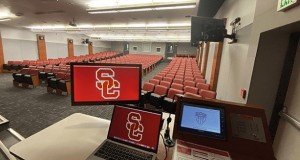Aktuelle News & Schlagzeilen
Corona: Audinate’s Dante helps USC reach students in the time of COVID-19
Joe Way, Director of Learning Environments at the University of Southern California (USC), located in Los Angeles, is working to redesign 248 learning spaces in his own vision. At the core of the installation is Audinate’s Dante - a network protocol that allows for digital media networking.
When Way first began to design the workflows for the learning spaces, he knew Dante infrastructure would run throughout the campus. Then, as construction commenced, the COVID-19 pandemic hit. Classes were shuttered, integration was placed temporarily on pause, and Way was asked to reconsider the build out. USC was no longer looking just at providing the most robust AV solutions for on-site coursework, labs and lectures, but needed to also be prepared for the likelihood of at least some blend of distance learning moving forward.
Way explained that the main challenge they are working to solve is to deploy hybrid solutions where a lecturer is physically in a room, and then captures the lecture audio/video in real time and transmits it out live to the web, while also recording and archiving the content for future use.
“What we’re finding and moving toward is offering a program where we have as many freshman classes in person as possible, and then the upper-division students on line”, says Way. “So, with that strategy, we’ll have about 20% actual in-person occupancy, with a hybrid solution covering remote attendees. We are moving to all-network-based AV. It will allow us to transmit any signal to any other location.”
The core of the system is the Crestron Flex UC Engine (the B140-Z or C160-Z). These allow users to take a Zoom Virtual Room and make it live - using all NVX352s to encode and decode Dante. The microphones are all Shure networked mics - either MXA 910s or 710s - and are all Dante enabled. They are used for lecture and student capture. A focus is placed on capturing the presenter, but the room placement is designed to work for everyone in the space.
Huddly IQ 4K cameras are used to follow the speakers, and they also auto-crop an area in 720p, preserving some bandwidth. The USC team physically extracted these cameras from a Crestron product. Also unique is the use of a NUC (Next Unit of Computing), where the Dante data comes out the decoder and then into a NUC where Shure’s IntelliMix Room Audio Processing Software is being used.
The rooms utilize projectors, which pass through the NVXs via HDMI then are routed over IP. The system is set to capture out of Zoom on the “far” end as well, both audio and video, to allow for collaboration between those in class and those distance learning. Many rooms have dual display setups, with the current working theory that content will be on one display while remote learners will be on the second display. All content will be live and recorded.
There is also a level of custom automation involved - an internal system (Ad Astra) allows for exporting of schedules to shared calendars. Essentially this allows for the system to know exactly what class and instructor is coming in and set the room up automatically. There is integration with the Blackboard platform as well - with recordings of classes being automatically uploaded and accessible by students.
Dante Avio units are in place in many locations, including at the encoders and for use with some handheld mics. There are some output uses as well, such as when the team needs to zone the room and cut the speakers near the microphone. Way is also utilizing a proprietary USC software platform to be able to maintain control of the system, while still offering faculty intuitive control and classroom scheduling options.
However, when it comes to managing the many Dante signals, Way is relying on Dante Domain Manager. He expects to manage up to 1,100 nodes of Dante when the integration is complete. Way says he also purchased more than 200 Dante Avio Adapters to ensure any legacy gear in the workflow would be quickly and easily linked to the network. He says the current project is “close to $2 million” in total cost. An analog build out, he notes, would be significantly larger.
SCHLAGZEILEN
news archiv
suche
© 1999 - 2025 Entertainment Technology Press Limited News Stories








![Robe [Header]](/images/general/sponsors/Robe-Banner-2022.jpg)